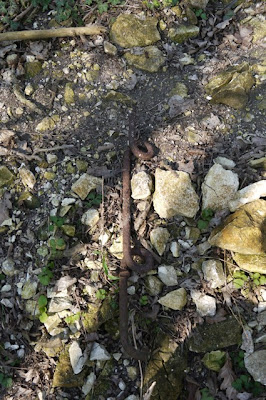We had a couple of brief visits to the French Sector of the Somme battlefields. I must admit we don't visit the French sector as often as we should but this is largely due to the lack of information published in English about the French contribution to this battle. Until recently the only real information was the Michelin Guide 'The First Battle of The Somme' published in the inter-war year!. Recently some authors are now beginning to put the battle in context by considering both the French and German involvement (e.g. W Philpott's 'Bloody Victory' and R Whitehead's 'The Other Side Of The Wire').
On the German side we visited Bois Y. This wood projected from the German front line and covered the position immediately north of the Somme river. The Germans had turned it into a strong redoubt packed with machine guns that could bring enfilade fire onto attacks from the north and south. This was the objective of the French 79 Regiment d'infanterie on July 1st. The French guns had done their work well, the German wire fully cut and trenches pulverised. The French infantry were through the German front position in 20 minutes, with only feeble German resistance encountered. This contrasts starkly with the progress of most of the British infantry on July 1st 1916, largely as a result of more heavy guns employed than the British and better fire and movement tactics (the French had learned their lessons from costly attacks in 1915 and the British were quick to learn from the disaster of 1st July).
Above:
Image 1: Aerial photo showing Bois Y (and the Ravens Tree), just south of Maricourt
Image 2: Bois Y which overlooks the Somme River Valley. The back of the wood plunges down into a ravine.
Image 3: Remains of dugout in Bois Y
Image 4: Remains of screw picket which has been hit by a shrapnel ball
Image 5: Trench, Bois Y
Image 6: Unexploded French Torpille a ailettes 58 No 1 (aero-torpedo), Bois Y
Image 7: French troops setting an aero-torpedo before launching. A cylinder attached to the shell fits into the tubing which forms the barrel of the gun and receives the propulsion from the discharge. It had a range of 350 mtrs. Remains of the cylinders littered Bois Y and the nearby ploughed fields.
Nearby can be seen some French trenches, also in woodland which drops down into a ravine. There is a local legend associated with a tree that survived the War unlike the wood which was decimated - the tree is locally known as 'The Ravens Tree' although technically speaking I think it should be 'The Rooks Tree' as Ravens don't breed in this part of France!
Above:
Image 1 - legend of 'The Ravens Tree'
Image 2: 'The Ravens Tree'
Image 3: Remains of dugout in nearby wood.
Image 4-6: Remains of trenches in nearby wood.













Comments
Post a Comment